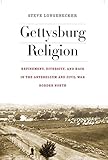Gettysburg Religion : Refinement, Diversity, and Race in the Antebellum and Civil War Border North / Steve Longenecker.
Material type: TextSeries: The North's Civil WarPublisher: New York, NY : Fordham University Press, [2014]Copyright date: ©2014Description: 1 online resource (264 p.)Content type:
TextSeries: The North's Civil WarPublisher: New York, NY : Fordham University Press, [2014]Copyright date: ©2014Description: 1 online resource (264 p.)Content type: - 9780823255191
- 9780823255214
- Religion and culture -- Pennsylvania -- Gettysburg Region -- History -- 19th century
- Religion and culture -- Pennsylvania -- Gettysburg -- History -- 19th century
- HISTORY / United States / Civil War Period (1850-1877)
- African American (Black)
- Civil War
- Civil religion
- Diversity
- Evangelicalism
- Gettysburg
- Lutheran
- Pennsylvania
- Race
- refinement
- 277.48/42081 23
- online - DeGruyter
| Item type | Current library | Call number | URL | Status | Notes | Barcode | |
|---|---|---|---|---|---|---|---|
 eBook
eBook
|
Biblioteca "Angelicum" Pont. Univ. S.Tommaso d'Aquino Nuvola online | online - DeGruyter (Browse shelf(Opens below)) | Online access | Not for loan (Accesso limitato) | Accesso per gli utenti autorizzati / Access for authorized users | (dgr)9780823255214 |
Frontmatter -- Contents -- Preface -- Acknowledgments -- Introduction -- Divertimento -- 1 Community -- Divertimento: Salome “Sallie” Myers -- 2 Refinement: In Theory -- 3 Refinement: In Practice -- Divertimento: The Codoris -- 4 Diversity: Ethnicity and Doctrine -- Divertimento: Abraham and Elizabeth Brien -- 5 Diversity: Race -- Divertimento: Mary and Joseph Sherfy -- 6 War -- Conclusion -- Divertimento: Thaddeus Stevens -- Coda -- Notes -- Bibliography -- Index
restricted access online access with authorization star
http://purl.org/coar/access_right/c_16ec
In the borderland between freedom and slavery, Gettysburg remains among the most legendary Civil War landmarks. A century and a half after the great battle, Cemetery Hill, the Seminary and its ridge, and the Peach Orchard remain powerful memories for their embodiment of the small-town North and their ability to touch themes vital to nineteenth-century religion. During this period, three patterns became particularly prominent: refinement, diversity, and war. In Gettysburg Religion, author Steve Longenecker explores the religious history of antebellum and Civil War–era Gettysburg, shedding light on the remarkable diversity of American religion and the intricate ways it interacted with the broader culture. Longenecker argues that Gettysburg religion revealed much about larger American society and about how trends in the Border North mirrored national developments. In many ways, Gettysburg and its surrounding Border North religion belonged to the future and signaled a coming pattern for modern America.
Mode of access: Internet via World Wide Web.
In English.
Description based on online resource; title from PDF title page (publisher's Web site, viewed 03. Jan 2023)


